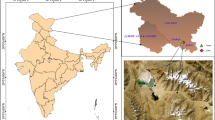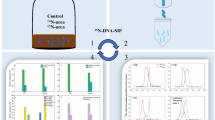Abstract
Soil nitrification rate is very different among soil types, as a result of differences in physical and chemical properties. Little is known about the composition of the nitrifying bacteria community. In this investigation, three soils (fluvo-aquic soil, permeable paddy soil and red earth) from different geo-ecological regions in China were characterized for their nitrification activities and their nitrifying bacteria communities determined either by molecular approaches or by conventional culture methods. A 28-day long-term soil incubation showed that the maximum nitrification potential was found in the fluvo-aquic soil with almost 100% of inorganic N present as NO −3 -N, while the minimum nitrification potential was in red earth with only a 4.9% conversion rate from ammonium into nitrate. There was no relationship between nitrification potential and numbers of nitrifiers in the soil. The conventional most probable number (MPN) method could enumerate ammonia oxidizers, but failed in enumerating nitrite oxidizers. Therefore, we used an MPN-PCR procedure which gave a convincing nitrite oxidizer count result, instead of MPN-diphylamine. Soils were characterized by denaturing gradient gel electrophoresis (DGGE) of DNA extracted from soils and amplified using a primer specific for the 16S rRNA gene and/or for the amoA gene. The DGGE columns of the three soils differed from each other. There were two similar bands present in DGGE columns of the fluvo-aquic and permeable paddy soils, but no similar band was found in DGGE columns of the red earth. The sequence of amoA indicated that all ammonia oxidizers in these soils were grouped into Nitrosospira clusters 1 and 3, and each soil had a common band similar to the other soils and a special band which differed from the other soils.





Similar content being viewed by others
References
Abbasi MK, Adams WA (1998) Loss of nitrogen in compacted grassland soil by simultaneous nitrification and denitrification. Plant Soil 200:265–277
Bengtsson G, Bergwall C (2000) Fate of 15N labelled nitrate and ammonium in a fertilized forest soil. Soil Biol Biochem 32:545–557
Both GJ, Gerards S, Laanbroek HJ (1990) Most probable numbers of chemolitho-autotrophic nitrite-oxidizing bacteria in well drained grass land soils: stimulation by high nitrite concentrations. FEMS Microbiol Ecol 74:287–294
Bruns MA, Stephen JR, Kowalchuk GA, Prosser JI, Paul EA (1999) Comparative diversity of ammonia oxidizer 16S r RNA gene sequences in native, tilled and successional soils. Appl Environ Microbiol 65:2994–3000
Cochran WG (1950) Estimation of bacterial densities by means of the most probable number. Biometrics 6:105–116
Degrange V, Bardin R (1995) Detection and counting of Nitrobacter populations in soil by PCR. Appl Environ Microbiol 61:2093–2098
Ferris MJ, Muyzer G, Ward DM (1996) Denaturing gradient gel electrophoresis profiles of 16S rRNA-defined populations inhabiting a hot spring microbial mat community. Appl Environ Microbiol 62:340–346
Hart SC, Stark JM, Davidson EA, Firestone MK (1994) Nitrogen mineralization, immobilization, and nitrification. In: Weaver RW, Angle JS, Bottomley PS (eds) Methods of soil analysis, part 2: microbiological and biochemical properties. Soil Science Society of America, Madison, Wis., pp 985–1018
Head IM, Hiorns WD, Embley TM, McCarthy AJ, Saunders JR (1993) The phylogeny of autotrophic ammonium-oxidizing bacteria as determined by analysis of 16S ribosomal RNA gene sequences. J Gen Microbiol 139:1147–1153
Hovanec TA, DeLong EF (1996) Comparative analysis of nitrifying bacteria associated with freshwater and marine aquaria. Appl Environ Microbiol 62:2888–2896
Juretschko S, Timmermann G, Schmid M, Schleifer KH, Pommerening-Roser A, Koops HP, Wang M (1998) Combined molecular and conventional analyses of nitrifying bacterium diversity in activated sludge: Nitrosococcus mobilis and Nitrospira-like bacteria as dominate populations. Appl Environ Microbiol 64:3042–3051
Klotz MG, Alzerreca J, Norton JM (1997) A gene encoding a membrane protein exists upstream of the amoA/amoB genes in ammonia oxidizing bacteria: a third member of the amo operon? FEMS Microbiol Lett 150:65–73
Kowalchuk GA, Stephen JR (2001) Ammonia-oxidizing bacteria: a model for molecular microbial ecology. Annu Rev Microbiol 55:485–529
Kowalchuk GA, Stephen JR, De Bore W, Prosser JI, Embley TM, Woldendorp JW (1997) Analysis of ammonia-oxidizing bacteria of the β subdivision of the class Proteobacteria in coastal sand dunes by denaturing gradient gel electrophoresis and sequencing of PCR-amplified 16S ribosomal DNA fragments. Appl Environ Microbiol 63(4):1489–1497
Kowalchuk GA, Naoumenko ZS, Derikx PJL, Felske A, Stephen JR, Arkhipchenko IA (1999) Molecular analysis of ammonia-oxidizing bacteria of the beta subdivision of the class Proteobacteria in compost and composting materials. Appl Environ Microbiol 65:396–403
McCaig AE, Embiey TM, Prosser JI (1994) Molecular analysis of enrichment cultures of marine ammonia oxidisers. FEMS Microbiol Lett 120:363–368
McTavish H, Fuchs JA, Hooper AB (1993) Sequence of the gene coding for ammonia monooxygenase in Nitrosomonas europaea. J Bacteriol 175:2436–2444
Muyzer G, de Waal EC, Uitterlinden AG (1993) Profiling of complex microbial populations by denaturing gradient gel electrophoresis analysis of polymerase chain reaction-amplified genes coding for 16S rRNA. Appl Environ Microbiol 59:695–700
Nannipieri P, Ascher J, Ceccherini MT, Landi L, Pietramellara G, Renella G (2003) Microbial diversity and soil functions. Eur J Soil Sci 54:655–670
Norton JM, Low JM, Martin G (1996) The gene encoding ammonia monooxygenase subunit A exists in three nearly identical copies in Nitrosospira sp. NpAV. FEMS Microbiol Lett 139:181–188
Purkhold U, Pommerening-Roser A, Juretschko S, Schko S, Schmid MC, Koops HP, Wagner M (2000) Phylogeny of all recognized species of ammonia oxidizers based on comparative 16S rRNA and amoA sequence analysis: implications for molecular diversity surveys. Appl Environ Microbiol 66:5368–5382
Rolleke S, Gurtner C, Drewello U, Drewello R, Lubitz W, Weissmann R (1999) Analysis of bacterial communities on historical glass by denaturing gradient gel electrophoresis of PCR-amplified gene fragments coding for 16S rRNA. J Microbiol Methods 36:107–114
Rotthauwe JH, Witzel KP, Liesack W (1997) The ammonia monooxygenase structural gene amoA as a functional marker: molecular fine-scale analysis of natural ammonia-oxidizing populations. Appl Environ Microbiol 63:4704–4712
Smorczewski WT, Schmidt EL (1991) Numbers, activities, and diversity of autotrophic ammonia-oxidizing bacteria in a freshwater, eutrophic lake sediment. Can J Microbiol 37:828–833
SPSS (1999) SPSS base 10.0: user’s guide. SPSS, Chicago
Ste-Marie C, Pare D (1999) Soil, pH and N availability effects on net nitrification in the forest floors of a range of boreal forest stands. Soil Biol Biochem 31:1579–1589
Stephen JR, McCaig AE, Smith Z, Prosser JI, Embley TM (1996) Molecular diversity of soil and marine 16S rRNA gene sequences related to beta-subgroup ammonia-oxidizing bacteria. Appl Environ Microbiol 62:4147–4154
Teske A, Elm E, Regan JM, Toze S, Rittmann BE, Stahl DA (1994) Evolutionary relationships among ammonia- and nitrite-oxidizing bacteria. J Bacteriol 176:6623–6630
Torsvik V, Sørheim R, Goksoyr J (1996) Total bacterial diversity in soil and sediment communities—a review. J Ind Microbiol 17:170–178
Troelstra SR, Wagenaar R, De Boer W (1990) Nitrification in Dutch heathland soils. I. General soil characteristics and nitrification in undisturbed soil cores. Plant Soil 127:179–192
Ward BB, Martino DP, Diaz MC, Joye SB (2000) Analysis of ammonia-oxidizing bacteria from hypersaline Mono Lake, California, on the basis of 16S rRNA sequences. Appl Environ Microbiol 66:2873–2881
Yeates C, Gillings MR, Davison AD, Altavilla N, Veal DA (1998) Methods for microbial DNA extraction from soil for PCR amplification. Biol Proc Online 1:40–47
Acknowledgements
The investigations were supported by grants from the National Nature Science Foundation of China (NSFC; nos. 40471074, 40271098).
Author information
Authors and Affiliations
Corresponding author
Rights and permissions
About this article
Cite this article
Yuan, F., Ran, W., Shen, Q. et al. Characterization of nitrifying bacteria communities of soils from different ecological regions of China by molecular and conventional methods. Biol Fertil Soils 41, 22–27 (2005). https://doi.org/10.1007/s00374-004-0802-y
Received:
Revised:
Accepted:
Published:
Issue Date:
DOI: https://doi.org/10.1007/s00374-004-0802-y




